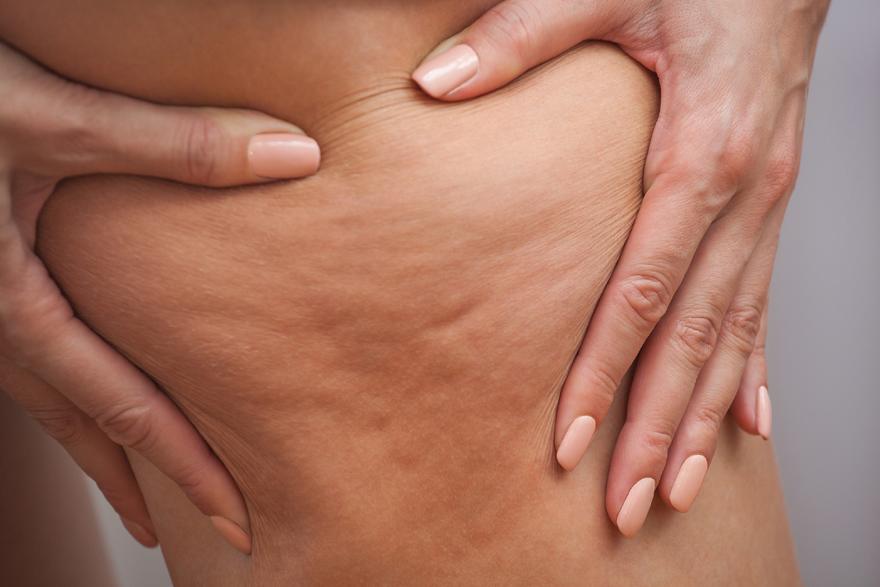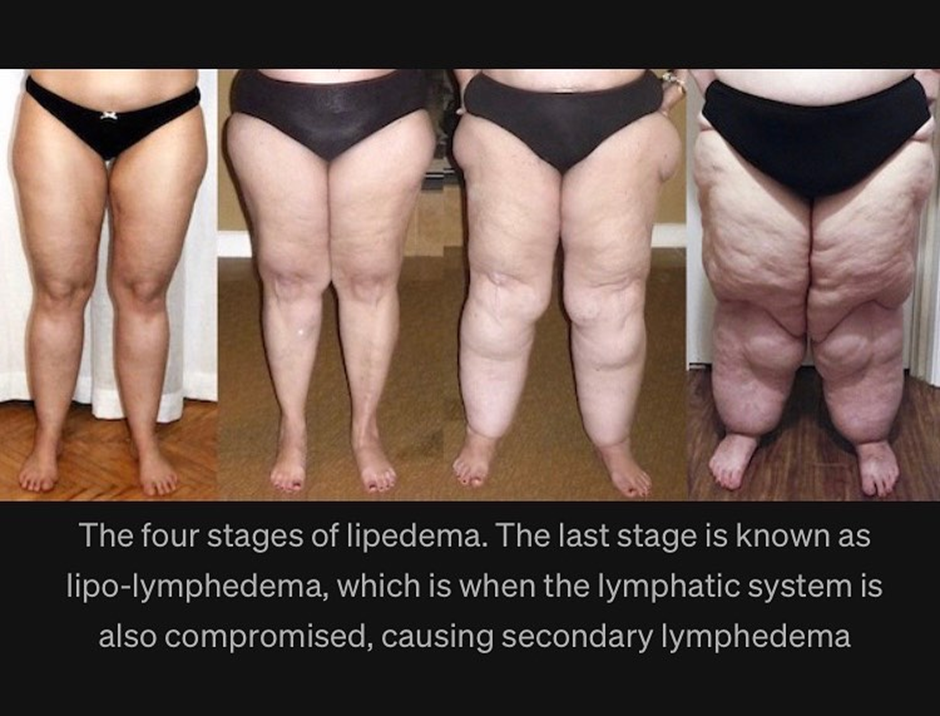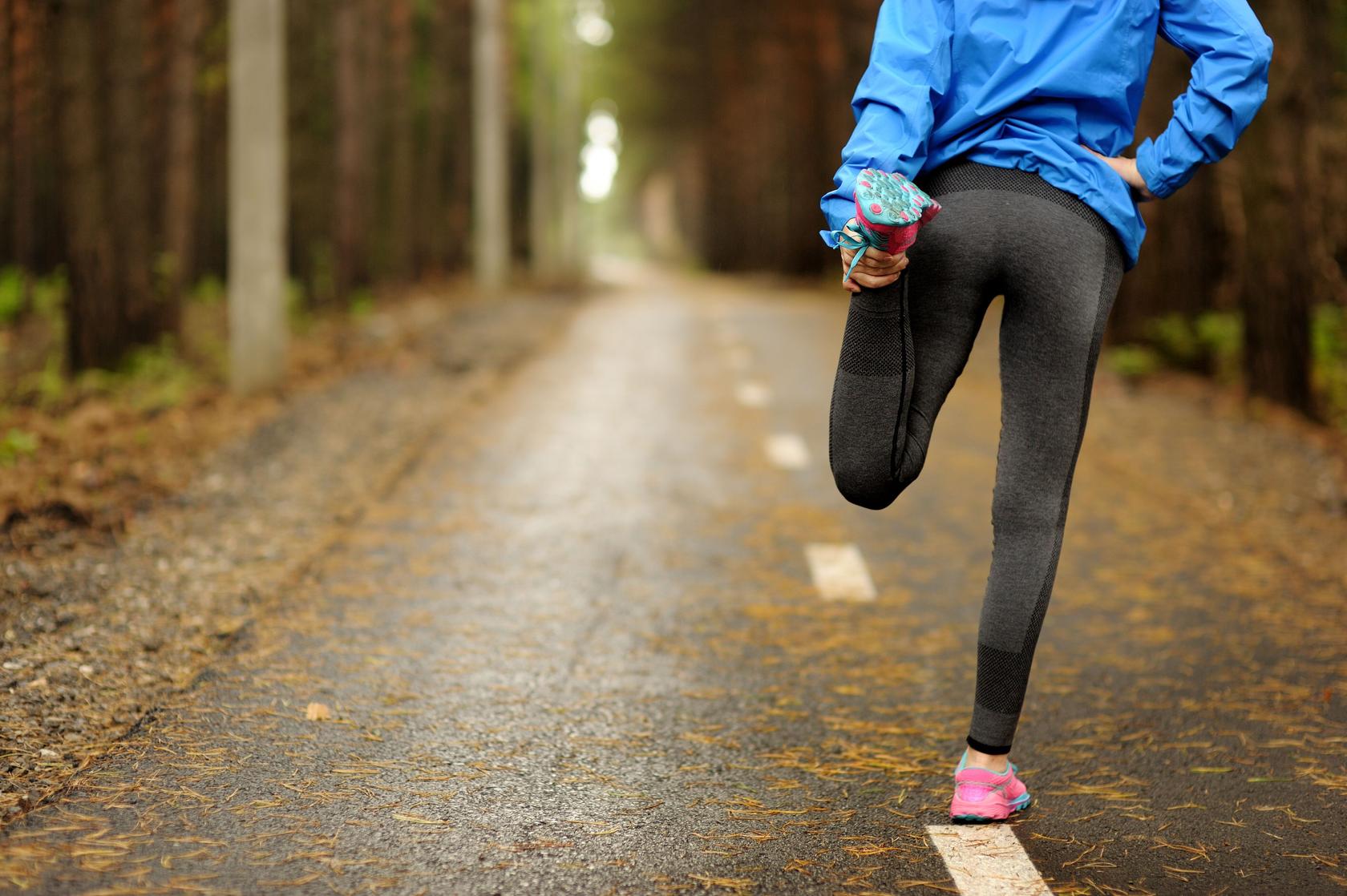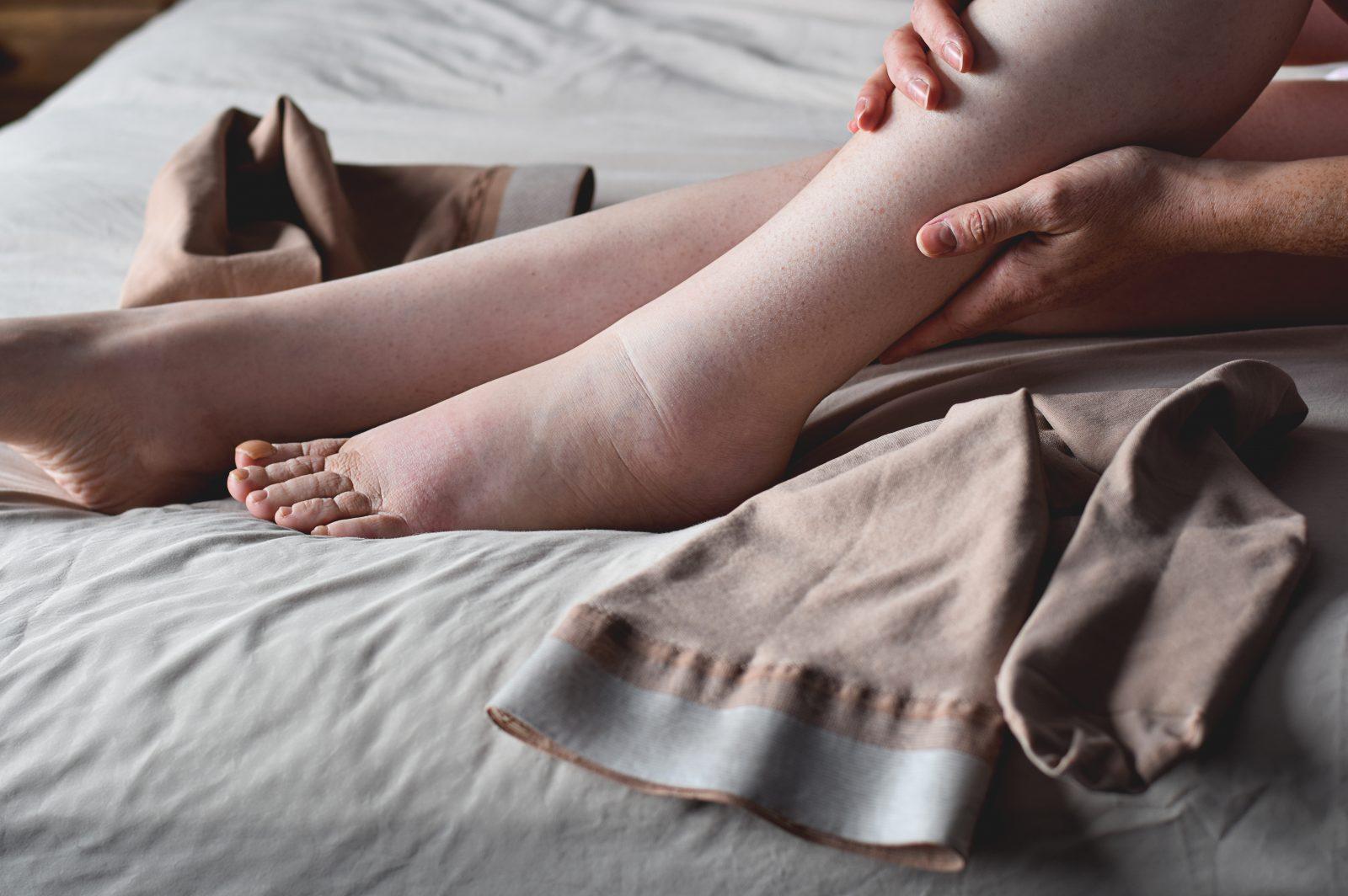Lipedema: What You Need to Know

June is Lipedema Awareness Month. (Lipedema is also known as Lipoedema.)
This medical condition is often misdiagnosed as obesity or Lymphedema because it involves the accumulation of fat on the hips, buttocks, legs, and upper arms and fluid in the lymph system. But it is much more than weight gain and much more than fluid in the lymph system.
Lipedema is unique and distinct.
If Lipedema is NOT diagnosed early and managed, it can lead to stubborn weight gain, chronic pain, immobility, and skin that is lumpy with fat nodules that are hard. It does not affect the hands, feet or torso.
This condition is beyond frustrating for the roughly 11% of women affected by this condition because it is unresponsive to dietary and exercise interventions. These lifestyle changes can lead to weight loss in other areas of the body but rarely those areas affected by lipedema.
Lipedema affects women of all ages and sizes and coincides with times of intense hormonal changes such as puberty, pregnancy and menopause.
The symptoms are clear and once you see the list you might be shocked to learn you have Lipedema. I certainly was! As a fit, normal weight, whole food woman, I was surprised to be diagnosed. (To confirm a diagnosis, be sure to visit your doctor.)
Lipedema Symptoms Checklist:
- Disproportionate accumulation of fat in the lower half of the body (mainly buttocks, hips and thighs).
- The fat is unresponsive to calorie restriction or exercise and typically gets worse over time.
- The skin feels cool, is painful to touch, and bruises easily.
- There are cyst-like fat nodules under the skin’s surface that range from rice granules to walnuts in size. These are known as “lipedema pearls”. These nodules get larger as the condition progresses.
- In later stages, the skin’s surface becomes loose, wrinkly and lumpy with fat nodules and bulges.
- The legs feel heavy and tired, even more so with walking, climbing, extended sitting, etc.
- Veins tend to be visible and fragile
- There’s often a ring of puffy fat at the ankles or wrists called a “cuff”
There are 4 stages of Lipedema with the symptoms getting progressively worse over time. Early diagnosis is critical to slowing down or arresting the progression of symptoms.
Stage 1: Skin is smooth. Fat is accumulating in lower half of body.
Stage 2: Skin is dimply, the adipose tissue has increased, an ankle cuff can be seen and fat nodules can be felt.
Stage 3: Skin is very lumpy with fatty protrusions, fat is painful to touch, legs can appear like columns, leg pain is significant, mobility is affected, fat nodules are larger.
Stage 4: Lipolymphedema. The Lymph system is impacted to the point that fluid is building up and creating a dual diagnosis of lipedema and Lymphedema. Skin is extremely dimpled, fat hangs off the body in affected areas, appears as obesity. It is not.
Here is a photo from Lipedema.org:

Although this condition was first diagnosed in the 1940s, there is still very little known about why this condition strikes some women (and occasionally men too). Some consider it an auto-immune disease, others claim it is a malfunctioning of the connective, vascular and lymphatic systems (possibly impacted by ultra-processed foods). Others note the role of hormones – potentially imbalanced female hormones – as a contributing root cause.
There is much to learn and progress to be made in terms of how to turn this profoundly frustrating adipose tissue issue (that stubbornly refuses to go away despite hours in the gym, fasting, and healthy eating) around.
This is not to say there are no options. In fact, in my next email, I will share some research and best practices.
If this condition is relevant to you, don’t think of this problem as just a weight-loss issue. It is not. It is a whole different beast.
For decades women affected by this condition have been told to lose weight by eating less (reduce calories) and moving more (burn calories). This advice, they painfully discovered, was ineffective and contributed to intense feelings of frustration, shame and self-loathing.
Despite the fact that this condition was first diagnosed in the 1940’s and affects anywhere from 11-18% of the female population, very little is known about this condition.
Interestingly, individuals with this condition can be overweight, normal weight and underweight. It has even been reported in anorexics. For this reason, it is clear that Lipedema is not just a weight gain issue. In fact, it is a serious abnormality of the body which is tied to our vascular, connective tissue, lymphatic, hormone and metabolic systems.
According to Dr. Jill Carnahan, MD and Functional Medical Doctor, Lipedema is (at least in part) a result of poor lymphatic drainage and stagnant blood flow in the adipose tissue directly beneath our skin. This means cellular waste, fluids, toxins, fat, etc., buildup inside this fat tissue. (1)
This buildup initiates an immune response (inflammation) that progressively deranges the fat tissue. Over time, this fat tissue becomes lumpy as a result of a process called fibrosis. These lumps are believed to be scar tissue and are sometimes referred to as ‘Lipedema Pearls’.
This lymph stagnation, fluid buildup and tissue degradation become a vicious cycle whereby the inflammation and scarring of the tissue gets progressively worse causing more stagnation, more blood flow blockage and more lymphatic malfunction (not to mention more pain). If not diagnosed and treated, Lipedema will become progressively more acute and ultimately debilitating.
Fortunately, regardless of how long you have had Lipedema or how far it has progressed there is HOPE.
In the rest of this article, I will focus on the powerful role that diet and exercise, as well as surgical and non-surgical treatments, can play in slowing down or reversing the symptoms of Lipedema. I will also share a link to 2 amazing YouTube videos that expand on this topic wonderfully well.
DIET

There is not a single website dedicated to the topic of Lipedema that does not mention the important role of diet in medically managing this condition.
The diets recommended by Lipedema experts run the gamut but are universally in agreement that all forms of processed foods need to be eliminated. This includes added sugars, refined carbs, additives and processed oils/fats.
Some websites claim (and early clinical research shows) the Keto diet can be effective at halting the progression of the condition and in some cases reducing lipedema fat. These types of results were once thought impossible but anecdotal and preliminary clinical research suggest otherwise.
In fact, there is a Youtube video that shares the story of a woman who was obese and wheel chair bound. After go Keto and implementing other non-surgical treatments, she lost most of her excess weight, dropped inches off her thighs, restored the functioning of her legs and went on to become a fitness instructor for a lipedema support group. It is pretty inspirational. I have included a link to this video for you below. (2)
If Keto is not your thing, no worries!
There are plenty of other clinics, doctors and experts recommending non-Keto Meal plans. For example, the Flinders Medical Clinic in Australia recommends a low fat, low carb, and mostly plant-based meal plan to its Lipedema patients. A link to their meal plan is below. (3)
The reason they recommend a low fat diet is to limit our consumption of long-chain fatty acids. This is fascinating to me...
In their own words:
“LCFA (Long Chain Fatty Acids) have to be absorbed from the intestine by the lymphatic system. This increased load may mean lymph from other areas (usually the lower limbs) cannot drain away as well or occasionally lymph fluid from the intestine finds its way in a reverse direction down into the limbs.” (3)
They go on to say:
“Substitute your fats with Medium Chain Fatty Acids (MCFA). This is because MCFA (and SCFA (Short Chain Fatty Acids)) can be absorbed from the intestine by the blood vessels, and so do not put additional load on your lymphatic system.” (3)
This caught my attention because in my case, my Lipedema seemed to get worse while I was eating Keto. The more fat I ate, the worse my symptoms became. So much so, that one day when I was looking in the mirror there was this weird puffy lump of fat on my neck just above my left clavicle. I remember pushing on it and thinking “what the heck is this?” This fat blob comes and goes as my LCFA intake ebbs and flows. If I had not read this article, I would never have noticed the connection. This may not be true for everyone.
In addition to the low fat, low carb, lots of vegetables diet, another diet is often recommended for Lipedema. It is called the RAD (Rare Adipose Disorder) Diet. This diet is focused on eliminating foods that reduce inflammation including processed foods, dairy products, fatty meats, refined carbs, bread, pasta, white rice, processed oils, etc.
In the words of Lipedema.com:
“Starve lymphedema and lipedema by avoiding added sugars (especially fructose), refined grains (especially grains containing gluten), and chemically modified fats. Limit animal products and high-salt foods. Avoiding dairy (other than kefir and yogurt) appears to help with lipedema.” (4)
In terms of the role of diet in Lipedema treatment, the bottom line is this… there are potentially many whole food meal plans you can experiment with to see which ones reduce your symptoms. But regardless of whether you eat Paleo, Keto or Vegan or anything in between the common denominator is the consistent elimination/minimization of quickie carbs, processed meats and oils.
For those of us with Lipedema, it is whole foods or bust.
NOTE: Eating whole food may or may not budge the lipedema fat although clinical evidence suggests it can shrink and it can be less painful. Eating whole foods can also help us sleep better, have more energy, improve our mood, etc. In short, we eat low glycemic whole foods not to lose weight but to stop the progression of a serious medical condition. Weight loss, if it happens, is bonus.
My favourite video on the topic of nutrition and Lipedema is called “Eating to Starve Lymphedema and Lipedema” by Chuck Ehrlich. A link to this video is included in the source section below. It is amazing. (5)
EXERCISE

Since this condition is largely related to stagnant lymph, which is like the sewage system of the body, individuals with Lipedema have to move their bodies to keep the lymphatic system working. The contraction of muscles, deep breathing and sweating all assist the body to clear toxins and move lymph.
Since pain and joint issues and the frequent co-existence of EDS (Ehlers-Danlos Syndrome) can complicate exercise, find an expert who can help you start small and exercise safely. If you have EDS you will need to be careful of high-impact exercise. A physiotherapist with expertise in EDS can help you build muscles to protect your joints while you incrementally increase your activity.
There is plenty of evidence that individuals with Lipedema can become incredibly fit and enjoy a high quality of life even if our lower limbs and upper arms are fatter than we think they should be. Loving our bodies as is and caring for them extra well is now non-negotiable. It comes with the territory of this medical diagnosis.
Despite the difficulty of exercising with Lipedema, it is not an excuse to avoid exercise. In fact, it is an urgent reason to do so. Gentle forms such as walking, swimming, or online ‘lymph yoga’ classes are ideal to start. I have included a link to an awesome Lymph Yoga video on Youtube in the Resources Section below. (6)
Remember, those of us with Lipedema must exercise for the relaxation, pleasure, medical and mental health benefits. Weight loss is bonus.
NON-SURGICAL TREATMENTS

The following medical interventions can assist with the treatment, management and improvement of Lipedema. I will only mention them briefly (so as to keep this email from being way too long) and let the documentary I share below, fill you in on the details.
MANUAL LYMPH DRAINAGE
Manual Lymph Drainage is a French technique developed by Dr. Emil Vodder and Estrid Vodder (his wife) that dates back to 1936. It is used to reduce swollen lymph nodes. This light, skin-stretching massage helps decongest swollen areas by promoting the movement of lymphatic fluid out of congested areas into areas that are less so. It is typically accompanied by rapid deep breathing before and after the treatment. This can be done on yourself or you can hire massage therapists with expertise in this technique.
PNEUMATIC PUMP
Pneumatic compression pumps are devices you can purchase and use at home. They are also available at doctor’s offices. They work similarly to manual lymphatic drainage massages. The pneumatic compression pump will help push fluids back to the center of your body for release.
COMPRESSION GARMENTS
Compression garments help to improve blood and lymph flow, reduce swelling, support the efficacy of other treatments and curb the progression of the condition. They are readily available on Amazon.
VIBRATION PLATES
There are some studies validating the benefits of Vibration Plates. They include increasing lymphatic flow, strengthening muscles and bones, reducing swelling and cortisol, improving balance, and promoting weight loss. One 2010 study also showed that Vibration machines reduced blood pressure. While they are generally considered safe, check with your doctor prior to use.
HONORABLE MENTIONS: DRY BRUSHING / CUPPING / ACUPUNCTURE / LASER THERAPY
Evidence of efficacy for the above-mentioned treatments are modest but worth mentioning. Just because something is not well studied (especially with an understudied condition like Lipedema), it doesn’t mean it isn’t helpful. Experiment as you see fit.
SURGICAL TREATMENT

Liposuction surgery is well known in the Lipedema world and has both pros, cons and limitations. The pros include: a decrease in fat tissue (with an average 2-3 pant size reduction), a decrease in swelling, leg heaviness and pain. Another pro is the surgery is usually done with local not general anesthesia. It is day surgery. Cons include: not all the fat is removed, it can come back, surgery complications can happen, some report a worsening of their symptoms and then there is the out-of-pocket expense factor. The surgery can cost between $10-$15,000 per treatment. I have included a peer-reviewed medical review of the Clinical Effectiveness of the procedure under resource below. (7)
SUMMARY
The bottom line is: This abnormal adipose tissue that is making our legs heavy and painful and our bodies stubbornly fat is not going to go away. But it can be improved and arrested and managed. Acceptance of this reality is the first step to a better life. We must let go of the delusion a diet can fix this. It can’t. But a comprehensive lifestyle makeover can make a huge difference. It will not only improve our Lipedema, it will improve our overall health and mental health too.
Lipedema can be seen as a wakeup call. It is that for me.
—Florence
SOURCES:
- https://www.dailyhabitchange.com/about-lipoedema
- https://torontophysiotherapy.ca/patient-guide-to-self-diagnosing-lipedema-and-lipo-lymphedema/
- https://lipedema-simplified.org/
- https://www.talklipoedema.org/
- https://www.lipedema.org/
- https://pubmed.ncbi.nlm.nih.gov/34049453/
- https://www.jillcarnahan.com/2021/02/25/what-you-need-to-know-about-ehlers-danlos/
- https://www.youtube.com/watch?v=SqBbixNE088
- http://www.gpcme.co.nz/pdf/2017%20North/Handouts/Lymphoedema/Lipoedema%20Diet.pdf
- https://www.lipedema.com/self-care/nutrition
- Amazing Lecture: https://www.youtube.com/watch?v=krBvYTfxJks
- Yoga for Lymphatic System: https://www.youtube.com/watch?v=Mt6J4Cy9d9U
- https://www.ncbi.nlm.nih.gov/books/NBK545818/
- Lipedema Documentary: https://www.youtube.com/watch?v=qeqZ0oBDpNk
- https://totallipedemacare.com/blog/lipedema-diet-and-nutrition-set-yourself-up-for-success-with-these-food-facts/
- https://www.cvmus.com/blog/4-things-you-must-know-accepting-lipedema-treatment
Join Our Sugar-Free Tribe!
Sign up now to get the latest news, updates, and information about Sugar Detox and Sugar Addiction.
0 comments
Leave a comment